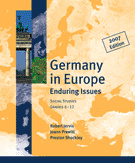Topic 2: Governing the European Union

Step #2: Extending and Refining Information
Strategy: Generalization/Principle Patterns
- How has the concept of nationalism been altered by the formation of the European Union?
Activities
Lay a world map on the floor and have the students gather around it. Have the students take turns naming the countries that make up the European Union.
Repeat the activity. This time, have the students give a name to the region that identifies the country as part of a specific region. (The name can be made up using geographic features within the region.) List the names of the regions on the board. See if some of the regions can be combined under one name.
Show Slide #8: Topic 2, Lesson 2 (Regionalism in Europe) and compare the regions showed on the map to the ones created in class. Talk about similarities and differences in describing a region. Ask the following the question:
- What constitutes a region?
Use Slide #9: Topic 2, Lesson 2 (Border Crossing Cooperation) and Slide #10: Topic 2, Lesson 2 (The Languages of Europe) to discuss how language and artificial borders complicate the issue of regionalism. Use this information to add information to your chart.
 Slide #9: Border Crossing Cooperation |
 Slide #10: Languages of Europe |
Use your chart to lead a discussion of the following question:
- What characteristics of regionalism help to define the European Union?
| Trait:
|
| Trait:
|
| Trait:
|

 Printable PDF
Printable PDF